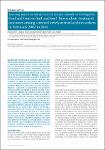Find and treat or find and lose? Tuberculosis treatment outcomes among screened newly arrived asylum seekers in Germany 2002 to 2014
Kuehne, Anna
Hauer, Barbara
Brodhun, Bonita
Haas, Walter
Fiebig, Lena
Background: Germany has a low tuberculosis (TB) incidence. A relevant and increasing proportion of TB cases is diagnosed among asylum seekers upon screening. Aim: We aimed to assess whether cases identified by screening asylum seekers had equally successful and completely reported treatment outcomes as cases diagnosed by passive case finding and contact tracing in the general population. Methods: We analysed characteristics and treatment outcomes of pulmonary TB cases notified in Germany between 2002 and 2014, stratified by mode of case finding. We performed three multivariable analyses with different dependent variables: Model A: successful vs all other outcomes, Model B: successful vs documented non-successful clinical outcome and Model C: known outcome vs lost to follow-up. Results: TB treatment success was highest among cases identified by contact tracing (87%; 3,139/3,591), followed by passive case finding (74%; 28,804/39,019) and by screening asylum seekers (60%; 884/1,474). Cases identified by screening asylum seekers had 2.4 times higher odds of not having a successful treatment outcome as opposed to all other outcomes (A), 1.4 times higher odds of not having a successful treatment outcome as opposed to known non-successful outcomes (B) and 2.3 times higher odds of loss to follow-up (C) than cases identified by passive case finding. Conclusion: Screened asylum seekers had poorer treatment outcomes and were more often lost to follow-up. Linking patients to treatment facilities and investigating potential barriers to treatment completion are needed to secure screening benefits for asylum seekers and communities.
No license information

